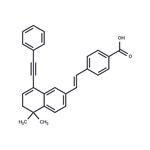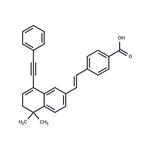Nuclear retinoic acid receptors (RARs) are transcriptional regulators with roles in cell proliferation and differentiation. BMS 493 is a pan-RAR inverse agonist that blocks RARα activity with an IC50 value of 114 nM. In all RAR types (RARα, RARβ, and RARγ), BMS493 prevents the recruitment of transcriptional coactivators to RARs while stabilizing corepressor interactions. BMS 493 has been used to elucidate the critical roles of RARs in development and immune response.
BMS 493 has been used:
- as an inhibitor for the dietary and pharmacologic manipulation of retinoic acid (RA) activity in vivo and in vitro
- for human induced pluripotent stem cells (iPSCs) culture and ventricular cardiomyocytes (VCMs) differentiation
- to inhibit retinoic acid (RA) signaling in explants
- as a retinoic acid receptor (RAR) inhibitor for the induction of synaptonemal complex protein 3 (SCP3) and ATP-dependent RNA helicase (DDX4) in primordial germ cells (PGCs)
ChEBI: BMS-493 is a member of the class of dihydronaphthalenes that is 1,2-dihydronaphthalene which is substituted at positions 1, 1, 4, and 6 by methyl, methyl, phenylethynyl, and 2-(p-carboxyphenyl)vinyl groups, respectively (the E isomer). It has a role as a retinoic acid receptor antagonist. It is a member of benzoic acids, a stilbenoid, a member of dihydronaphthalenes and an acetylenic compound.
BMS 493 inhibits the formation of neuritic processes and plasmenyethanolamine -phospholipase A2 (PLA2) activity.
BMS 493 is an inverse pan-RAR agonist. Retinoic acid receptors (RARs) are ligand-dependent transcription factors that control a number of physiological processes. RARs exert their functions by regulating gene networks controlling cell growth, differentiation, survival, and death.
![4-[(1E)-2-[5,6-Dihydro-5,5-dimethyl-8-(2-phenylethynyl)-2-naphthalenyl]ethenyl]benzoicacid Structure](/CAS/20180808/GIF/215030-90-3.gif)

